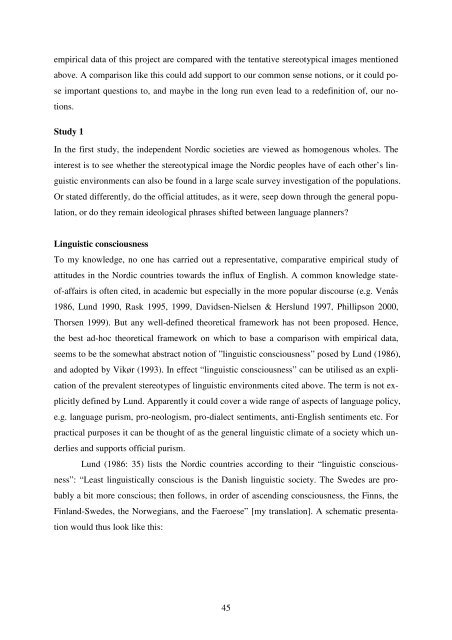Hør dog hvad de siger - Note-to-Self: Trials & Errors
Hør dog hvad de siger - Note-to-Self: Trials & Errors
Hør dog hvad de siger - Note-to-Self: Trials & Errors
Create successful ePaper yourself
Turn your PDF publications into a flip-book with our unique Google optimized e-Paper software.
empirical data of this project are compared with the tentative stereotypical images mentioned<br />
above. A comparison like this could add support <strong>to</strong> our common sense notions, or it could po-<br />
se important questions <strong>to</strong>, and maybe in the long run even lead <strong>to</strong> a re<strong>de</strong>finition of, our no-<br />
tions.<br />
Study 1<br />
In the first study, the in<strong>de</strong>pen<strong>de</strong>nt Nordic societies are viewed as homogenous wholes. The<br />
interest is <strong>to</strong> see whether the stereotypical image the Nordic peoples have of each other’s lin-<br />
guistic environments can also be found in a large scale survey investigation of the populations.<br />
Or stated differently, do the official attitu<strong>de</strong>s, as it were, seep down through the general popu-<br />
lation, or do they remain i<strong>de</strong>ological phrases shifted between language planners?<br />
Linguistic consciousness<br />
To my knowledge, no one has carried out a representative, comparative empirical study of<br />
attitu<strong>de</strong>s in the Nordic countries <strong>to</strong>wards the influx of English. A common knowledge state-<br />
of-affairs is often cited, in aca<strong>de</strong>mic but especially in the more popular discourse (e.g. Venås<br />
1986, Lund 1990, Rask 1995, 1999, Davidsen-Nielsen & Herslund 1997, Phillipson 2000,<br />
Thorsen 1999). But any well-<strong>de</strong>fined theoretical framework has not been proposed. Hence,<br />
the best ad-hoc theoretical framework on which <strong>to</strong> base a comparison with empirical data,<br />
seems <strong>to</strong> be the somewhat abstract notion of ”linguistic consciousness” posed by Lund (1986),<br />
and adopted by Vikør (1993). In effect “linguistic consciousness” can be utilised as an expli-<br />
cation of the prevalent stereotypes of linguistic environments cited above. The term is not ex-<br />
plicitly <strong>de</strong>fined by Lund. Apparently it could cover a wi<strong>de</strong> range of aspects of language policy,<br />
e.g. language purism, pro-neologism, pro-dialect sentiments, anti-English sentiments etc. For<br />
practical purposes it can be thought of as the general linguistic climate of a society which un-<br />
<strong>de</strong>rlies and supports official purism.<br />
Lund (1986: 35) lists the Nordic countries according <strong>to</strong> their “linguistic conscious-<br />
ness”: “Least linguistically conscious is the Danish linguistic society. The Swe<strong>de</strong>s are pro-<br />
bably a bit more conscious; then follows, in or<strong>de</strong>r of ascending consciousness, the Finns, the<br />
Finland-Swe<strong>de</strong>s, the Norwegians, and the Faeroese” [my translation]. A schematic presenta-<br />
tion would thus look like this:<br />
45



